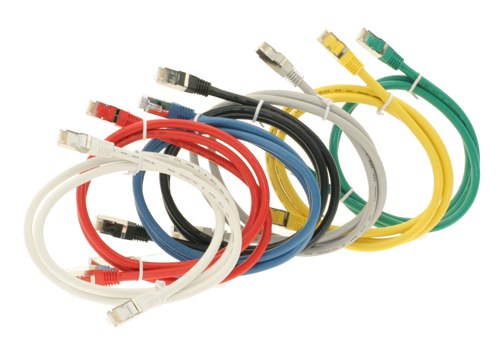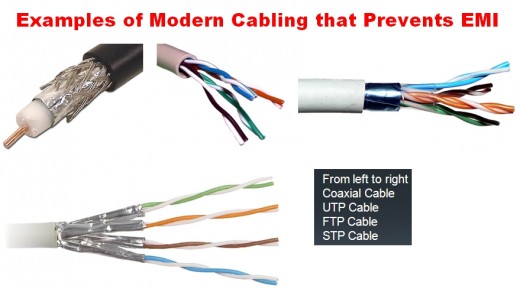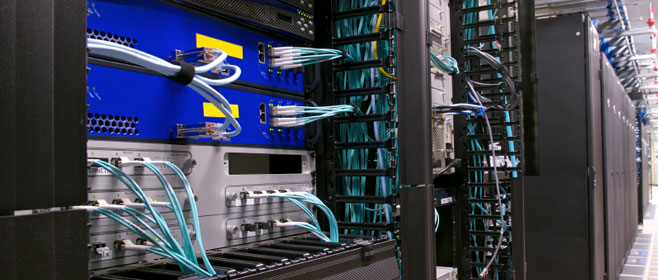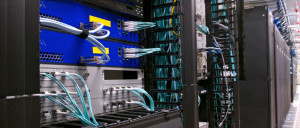
Data Center Cabling Best Practices – Part 3
 As mentioned previously, modern data centers must be flexible, scalable, reliable, and manageable, making best practices required. Part 3 will cover Color Identification and Naming Scheme.
As mentioned previously, modern data centers must be flexible, scalable, reliable, and manageable, making best practices required. Part 3 will cover Color Identification and Naming Scheme.
Color Identification
A method of fast visual identification, color coding makes management simpler, conserving time spent on the tracing of cables. Patch panel ports can also be coded, and various colored jacks and inserts are also coded. As determined by a particular manufacturer’s own color scheme, cables are available in numerous colors, each of which can be made applicable to the specific function of a cable or connection type.
Color schemes are expandable through the use of color bands at the end of every cable, using various colored sleeves and colored ports on the patch panel. However, it will also be necessary to use a secondary non-color scheme to make it possible for those who are color blind to identify the cables.
Naming Schemes
After determining the physical layout for the cabling that will be used, use a naming scheme that can be logically applied for facilitating fast and effortless identification of every cable component. Labeling can be an especially effective way to improve team communication among staff members because it makes confusion and uncertainty unlikely when a colleague must search for a particular component. Clear labeling is integral to the success of the naming scheme, and it should not be neglected.
A good naming scheme documents and labels every cable component. The following is the typical hierarchy for a naming scheme: Building, Room, Rack, Patch Panel, Workstation Outlet, Port, and Cable. Each should receive a designation indicating its location preceded by the area(s) above it. For example, Rack A03 would receive the designation SJ01-5D11-A03, if Room is designated SJ01-5D11, and Building is designated SJ01.
Upon the approval of the naming scheme, your team can begin labeling components. The team should prioritize drafting a manual that details the naming scheme and include it as part of the training program for newly hired data center administrators.
The Best Practices for Cable Component Selection will be discussed in the next series.
Union Network Cabling
When your work requires a unionized cabling group, call on Progressive Office Inc. for your commercial Cat5e/6/6a and fiber cabling projects. Specializing in cabling for data, voice, security and even the latest WiFi and LiFi solutions. Phone: (202) 462-4290

Data Center Cabling Best Practices – Part 2
 As mentioned in Part 1, modern data centers must be flexible, scalable, reliable, and manageable, making best practices required. Part 2 will cover cabling for Modular Data, High Density/High Port Count Fiber Equipment, and Standards.
As mentioned in Part 1, modern data centers must be flexible, scalable, reliable, and manageable, making best practices required. Part 2 will cover cabling for Modular Data, High Density/High Port Count Fiber Equipment, and Standards.
Modular Data
Increasing in popularity, modular cabling systems for fiber and copper connectivity introduces the plug-and-play concept, which simplifies cable installation and significantly decreases costs and labor. Typically, cables are factory-terminated and tested.
While modular cabling is less costly when the infrastructure is modified in-house, it will not be as flexible because of the possible required commitment to a vendor for ongoing compatibility.
High Density/High Port Count Fiber Equipment
When networking equipment gradually grows in density and port counts rise to several hundred, the proper management of the connected cabling will also require increased effort.
In the past, the direct connection of cables to individual ports of equipment with low port-counts was thought to be manageable. Unfortunately, the same task will be very time consuming for high-density/high-port-count equipment. Eventually, the addition or removal of cables directly connected to these ports will be almost impossible.
The utilization of Multifiber Push-On (MPO) cable assemblies featuring a single connector at one end of cable and multiple duplex breakout cables at the other end will ease cable management.
The concept revolves around pre-connecting high-density/high- port-count Lucent Connector (LC) equipment with LC-MPO fan-out cable to dedicated MPO modules inside a dedicated patch panel. Once completely cabled, this patch panel will work as "remote" ports. Ideally the patch panels should be located on top of the cabling equipment to facilitate access to overhead cabling. This method significantly decreases cluttering of equipment and cables, resulting in improved cable management.
Standards
The ISO (International Organization for Standardization) and TIA (Telecommunications Industry Association) are the main organizations that develop structured cabling standards for the industry. IEEE (Institute of Electrical and Electronics Engineers) committees do the testing and then set performance specifications.
Standards compliance makes sure that systems function at specified levels, allows backward compatibility, and a greater variety of equipment will be available internationally. Widespread global acceptance of standards allows the sourcing and use of equipment manufactured by different countries.
Color Identification and Naming Scheme will be discussed in Part 3.
Union Network Cabling
When union work requires a unionized cabling group, call on Union Network Cabling for your commercial Cat5e/6/6a and fiber cabling projects. Specializing in cabling for data, voice, security and even the latest WiFi and LiFi solutions. Phone: (202) 462-4290

Data Center Cabling Best Practices – Part 1
 Modern data centers are equipped with devices and networking equipment that connect them. These devices demand increasingly greater bandwidth, and so their fiber or copper cabling must perform at a high level. Today’s data centers must be flexible, scalable, reliable, and manageable, making best practices required.
Modern data centers are equipped with devices and networking equipment that connect them. These devices demand increasingly greater bandwidth, and so their fiber or copper cabling must perform at a high level. Today’s data centers must be flexible, scalable, reliable, and manageable, making best practices required.
Planning the Infrastructure
Thus, documenting the existing and planned network, along with its equipment is needed. A flexible patching structure will permit the interconnection of devices at desired locations.
Structured Cabling
The structured approach of cabling revolves around the design of runs and connections that ease cable identification, maintenance, repair, and future expansion or reconfiguration. A Main Distribution Area (MDA) and Horizontal Distribution Area(s) (HDAs), along with two-post racks that permit improved access and cable management, will be needed.
MDA and HDA components must be of high quality and capable of bearing expected future loads. Their layout should have horizontal and vertical cable managers. The MDA contains primary cross-connects and core networking equipment. The HDA contains the cross-connects for the distribution of cables to Equipment Distribution Areas (EDAs). Patch cables will connect servers and storage by utilizing patch panels at their respective EDA.
Next, the equipment racks inside the data center must have their layout determined. A horizontal cabling configuration will be used for the distribution of cables from the HDA to the EDA. Flexible connectivity is required by a dynamic data center environment. The goal is the implementation of a system that transmits fiber channel, Ethernet, and other protocols.
Future port and application requirements will also need to be considered. Expansion and technological advances must be anticipated, so the installation of ports and cabling needed in the future should be done now to save on labor costs and downtime if upgrades are needed.
Structured Infrastructure Benefits
- Cable identification and fault isolation simplified
- Consistent cabling lays sound foundation for future
- Future expansions and modifications made easier
- Standard-compliant components from multiple vendors possible
- Flexible connections provided
Union Network Cabling
When union work requires a unionized cabling group, call on Progressive Office Network Cabling for your commercial Cat5e/6/6a and fiber cabling projects. Specializing in cabling for data, voice, security and even the latest WiFi and LiFi solutions. Phone: (202) 462-4290

